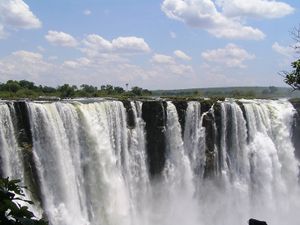Victoria Falls: Difference between revisions
No edit summary |
No edit summary |
||
| Line 28: | Line 28: | ||
}} | }} | ||
'''Victoria Falls''', or '''Mosi-oa-Tunya'''Tonga: ''the Smoke that Thunders''), is a waterfall in southern Africa on the [[Zambezi River]] at the border of Zambia and Zimbabwe. | '''Victoria Falls''', or '''Mosi-oa-Tunya'''Tonga: ''the Smoke that Thunders''), is a waterfall in southern Africa on the [[Zambezi River]] at the border of Zambia and Zimbabwe. | ||
==Naming== | |||
[[David Livingstone]], the Scottish missionary and explorer, is believed to have been the first European to view Victoria Falls on 16 November 1855 from what is now known as [[Livingstone Island]], one of two land masses in the middle of the river, immediately upstream from the falls on the Zambian side.<ref name="Livingstone!!! Tourism.com">{{cite web|url=http://www.livingstonetourism.com|title=Livingstone Tourism Association, Victoria Falls, Zambia - Livingstone, Zambia|work=livingstonetourism.com}}</ref> Livingstone named his discovery in honour of [[Queen Victoria|Queen Victoria of Britain]], but the indigenous name, Mosi-oa-Tunya—"the smoke that thunders"—continues in common usage as well. The nearby national park in Zambia is named ''Mosi-oa-Tunya'',<ref name=wicezm>''National Parks and Nature Reserves of Zambia'', [http://www.nationalparks-worldwide.info/zambia.htm World Institute for Conservation and Environment].</ref> whereas the national park and town on the Zimbabwean shore are both named ''Victoria Falls''.<ref name=wicezw>''National Parks and Nature Reserves of Zimbabwe'', [http://www.nationalparks-worldwide.info/zimbabwe.htm World Institute for Conservation and Environment].</ref><ref>{{cite web|title=Medium Term Plan (MTP): January 2010 – December 2015|publisher=Government of Zimbabwe|url=http://www.kubatana.net/docs/econ/goz_medium_term_plan_100706.pdf|accessdate=2013-05-15}}</ref> The [[World Heritage List]] officially recognizes both names.<ref name="WW"/> | |||
In 2013, the government of Zimbabwe declared its intention to officially rename the falls "Mosi-oa-Tunya", citing continuity with other renamings such as [[Harare]] (from Salisbury), and Zimbabwe (from [[Rhodesia]]).<ref name=Mosi2013>{{cite news|last=Shoko|first=Janet|title=Zimbabwe to rename Victoria Falls in anti-colonial name bid|url=http://www.theafricareport.com/Southern-Africa/zimbabwe-to-rename-victoria-falls-in-anti-colonial-name-bid.html?utm_source=feedburner&utm_medium=feed&utm_campaign=Feed%3A+tar-home+%28The+Africa+Report.com+-+Latest+news%29&utm_content=FaceBook|accessdate=18 December 2013|newspaper=The Africa Report|date=17 December 2013}}</ref> | |||
Revision as of 14:06, 23 June 2016
| Victoria Falls | |
|---|---|
| Mosi-oa-Tunya | |
 Victoria Falls | |
| Location | Livingstone, Zambia Victoria Falls, Zimbabwe |
| Coordinates | 17°55′28″S 25°51′24″E / 17.92444°S 25.85667°ECoordinates: 17°55′28″S 25°51′24″E / 17.92444°S 25.85667°E |
| Type | Waterfall |
| Total height | 355 ft (108 m) (at center) |
| Number of drops | 1 |
| Watercourse | Zambezi River |
| Average flow rate | 1088 m3/s (38,430 cu ft/s) |
| Official name | Mosi-oa-Tunya / Victoria Falls |
| Type | Natural |
| Criteria | vii, viii |
| Designated | 1989 (13th session) |
| Reference no. | 509 |
| State Party | Zambia and Zimbabwe |
| Region | Africa |
Victoria Falls, or Mosi-oa-TunyaTonga: the Smoke that Thunders), is a waterfall in southern Africa on the Zambezi River at the border of Zambia and Zimbabwe.
Naming
David Livingstone, the Scottish missionary and explorer, is believed to have been the first European to view Victoria Falls on 16 November 1855 from what is now known as Livingstone Island, one of two land masses in the middle of the river, immediately upstream from the falls on the Zambian side.[1] Livingstone named his discovery in honour of Queen Victoria of Britain, but the indigenous name, Mosi-oa-Tunya—"the smoke that thunders"—continues in common usage as well. The nearby national park in Zambia is named Mosi-oa-Tunya,[2] whereas the national park and town on the Zimbabwean shore are both named Victoria Falls.[3][4] The World Heritage List officially recognizes both names.[5]
In 2013, the government of Zimbabwe declared its intention to officially rename the falls "Mosi-oa-Tunya", citing continuity with other renamings such as Harare (from Salisbury), and Zimbabwe (from Rhodesia).[6]
- ↑ Lua error in ...ribunto/includes/engines/LuaCommon/lualib/mwInit.lua at line 23: bad argument #1 to 'old_ipairs' (table expected, got nil).
- ↑ National Parks and Nature Reserves of Zambia, World Institute for Conservation and Environment.
- ↑ National Parks and Nature Reserves of Zimbabwe, World Institute for Conservation and Environment.
- ↑ Lua error in ...ribunto/includes/engines/LuaCommon/lualib/mwInit.lua at line 23: bad argument #1 to 'old_ipairs' (table expected, got nil).
- ↑ Cite error: Invalid
<ref>tag; no text was provided for refs namedWW - ↑ Lua error in ...ribunto/includes/engines/LuaCommon/lualib/mwInit.lua at line 23: bad argument #1 to 'old_ipairs' (table expected, got nil).